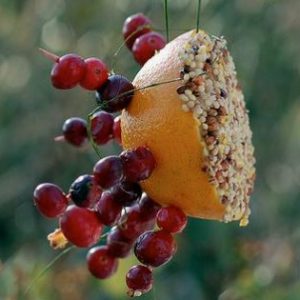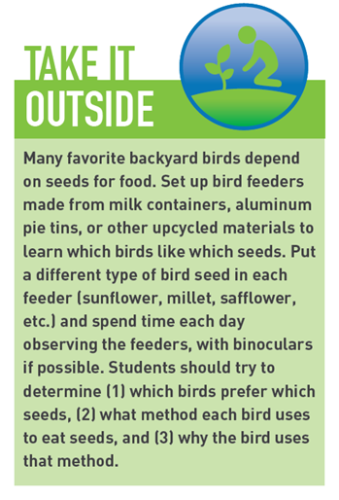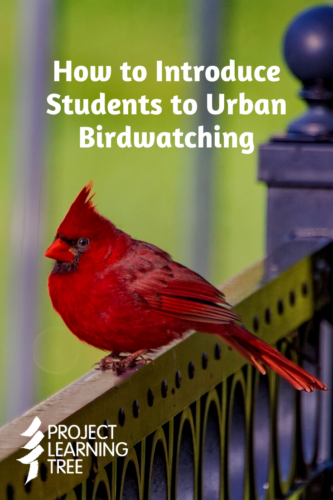
We love introducing kids to new ways to enjoy their immediate environments. For kids in urban areas, that can sometimes feel challenging. Urban birdwatching is an easy activity to open their eyes to the natural environment around them and how incredible birds are at making homes wherever they land.
We’re going to look at how to get started with urban birdwatching at your school, daycare, summer camp, or home, along with bird-themed activities that you can adapt for your classroom.
Editor’s note: PLT is inspired by the incredible educators and environmentalists dedicated to ensuring that nature and birds are for everyone to enjoy. The first week of June was Black Birders Week 2022. Catch up on events, themes, and important conversations that you can continue with youth, and meet some of the organizers and get tips for ways to be more welcoming and inclusive outdoors.
A Brief Guide to Urban Birdwatching
Urban birdwatching has always been rooted in accessibility. No matter where you live, you can be an urban birdwatcher. The hobby was popularized by people like David Lindo, the British birdwatcher, naturalist, and author known as the “Urban Birder.”
Lindo has always been interested in becoming more in tune with nature no matter where you are. For him, that often means cities and urban areas where birdwatching may seem too difficult or not as rewarding as in forests and conservation areas.
Getting started is easy. Just look for birds! Birds are all around you, whether you’re sitting in a coffee shop, at a local park, or just outside a classroom. Here are a few more tips from Lindo on urban birding:
- Focus less on checking birds off a list and more on what you see and hear. It’s not a competition, but a lesson in observation.
- Embrace birding as an escape. Once you introduce activities in the classroom, it should give your students time away from their devices and any school stresses.
- Enjoy and appreciate the birds you encounter. Urban birds in particular are resilient creatures. Take notice of the habitats they’ve created in unexpected areas.
Jump to:
Discover Your Urban Forest
You can also discover your urban forests with PLT’s activity collection, which includes three PLT activities from Explore Your Environment: K-8 Activity Guide to help students value diverse perspectives about different landscapes, whether a city sidewalk or an urban forest or a community park.
Activities
1. Decisions, Decisions
Decisions about community land use are complex and often involve many people in many ways. Students use trees as a backdrop to develop a land-use plan.
2. Environmental Justice for All
Everyone has an equal right to a healthy environment—but does everyone have a healthy environment? Students propose actions to resolve various scenarios and then research issues related to environmental justice in their own state.
3. Forest in the City
The trees in our communities provide many benefits: they improve air quality, store carbon, and conserve energy. Trees also enhance human health by reducing blood pressure, decreasing stress, and elevating attentiveness. Students conduct a survey to investigate the social and psychological effects of the urban forest.
Birdwatching Activities & Getting Started
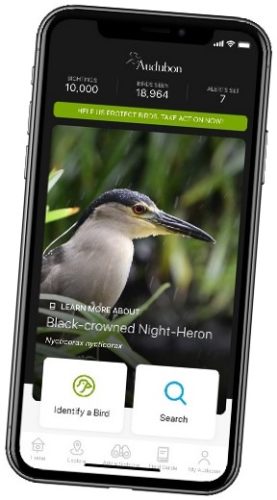
If you’re working in an urban environment, you don’t need anything fancy to get started. Binoculars are nice for hobbyists, but they aren’t necessary for our purposes here. You don’t even need to leave the school or summer campgrounds—or your backyard!
You will want to familiarize yourself with the types of birds you might encounter around your environment. Find a list of the most common species in your area and spend some time observing birds on your own before bringing kids in on the fun. You want to set them up for success.
Use a field guide like the Sibley Guide to Birds or an app to help you identify birds you see often. Free apps include:
Highly-rated paid apps include:
- iBird Pro Guide to Birds
- Sibley Birds 2nd Edition
From there, all you need is time and enthusiasm for birds to share with your children. Remember that bird observation sessions don’t have to be long, but they should be consistent. About 10 minutes is usually enough time to notice changes in the local environment.
Let’s dive into some fun birding activities with your classroom, campers, or home!
Get to Know the Local Birds
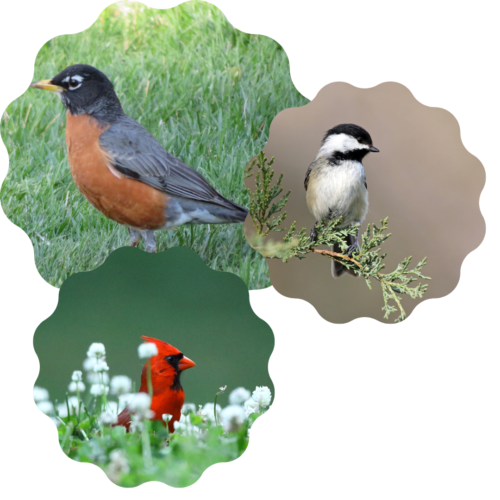 Spend some time introducing your kids to the local birds. Share your list of the most common species you’ve observed, and have your students embrace the idea of birdwatching over time. What changes do they observe in the local populations over a month, semester, or even school year?
Spend some time introducing your kids to the local birds. Share your list of the most common species you’ve observed, and have your students embrace the idea of birdwatching over time. What changes do they observe in the local populations over a month, semester, or even school year?
Note: If you or your students notice a bird that is not on the list of native species, this may be a good way to introduce the idea of invasive species. What do invasive bird species do to local plants and other animals? Do they have any effect on local bird populations?
Use PLT’s activity, Invasive Species from your Explore Your Environment: K-8 Activity Guide to help introduce learners in grades 3-5 and 6-8 to the problems invasive species can cause.
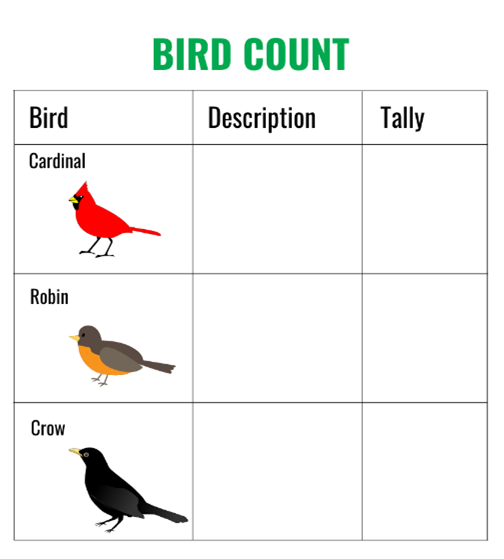
Compare and Contrast Local Birds
Encourage children to notice similarities and differences among the birds. If there are only a few available species, try comparing and contrasting birds with species they may know, like cardinals or robins.
Turn this activity into a fun math lesson by comparing and contrasting bird lengths from beak to tail. Use information from your bird guides or apps for accurate measurements. Chart the findings on a board in the classroom. You can also chart how often you see one type of bird over the others. Create appropriate hypotheses about why some birds are more obvious than others as appropriate by grade level.
Explore Bird Environments
Introduce your students to different kinds of bird environments and how urban birds need to make do with some unique nesting spots. This can include the tops of buildings, underneath bridges, and inside building crevices.
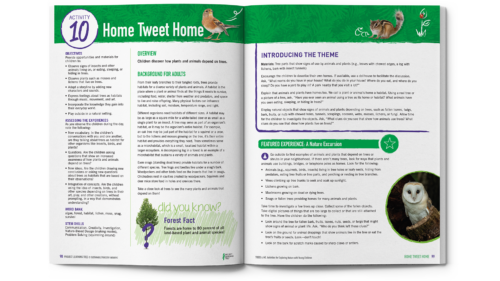
Ask them to reflect on how these environments are similar to or different from trees. This could even become a fun, creative writing activity from the perspective of an urban bird who has made a home out of a unique place.
If you have access to a local park with traditional bird nests and trees, observe whether some birds prefer one type of tree or another. Help them develop theories about why this may be, followed by instruction around trees that make good bird habitats.
Introduce your young learners ages 1-6 to how animals depend on trees with Activity 10: Home Tweet Home in PLT’s new Trees & Me: Activities for Exploring Nature with Young Children
Learn About Changing Seasons
Bring your students out for bird observation year-round, especially if your classroom is in a city with changing seasons. Are there populations of birds that disappear when the weather gets colder? Introduce the idea of bird migrations.
Observe any changes in the habits or behavior of your local birds. Some birds spend more time feeding in the spring to prepare for mating and nesting. Others adapt their diets to what’s available from season to season. Some may even join mixed flocks if they have similar nesting or feeding needs.
Listen to Bird Songs
Advanced birders use their ears just as their eyes when identifying bird species. Introduce youth to different bird songs while inside the classroom or at home, even using those songs as background noise during small group or individual activities. Challenge them to see if they can identify birds by their songs once they’re observing birds outside. Bring audio reinforcements to confirm any guesses.
Make Bird Feeders
Check local transmission rates for bird flu before you make plans to build a bird feeder (experts recommend avoiding using both bird feeders and bird baths when avian flu transmission rates are high to prevent the spread of these pathogens.)
Once it’s safe to make bird feeders, choose seeds that attract native species that have learned to use feeders to supplement their diets. Sunflower seeds are the most popular seeds used in homemade bird feeders and a favorite for many songbirds. If you have cardinals in the area, they prefer safflower seeds.
Here are bird feeders you can build with your students or at home with children.
Plant a Birdwatching Garden
Birds love plants and flowers no matter where they are. Plant a birdwatching garden with your students to attract your local bird species. Choose a spot that you can visit during birdwatching sessions. A garden right outside your classroom window may sound ideal at first, but it could also be a distraction for your students.
Try to plant native plant species to encourage interaction in natural environments. Here are a few examples of flowers birds love:
- Daisies: Finches, sparrows, and cardinals love munching on daisies.
- Milkweed: Finches like to use this flower’s fibers for their nests.
- Sunflowers: Birds love to feed on sunflower seeds to fuel upcoming migrations.
Join the Birdwatching Community
All of this work throughout the year has likely turned your students into amateur birders. Some of them may even resemble experts by the end of the year! Plan a lesson around contributing their observations to the greater birdwatching community. This can even be something your students do independently when working with older students.
The Cornell Lab of Ornithology runs the user-friendly Celebrate Urban Birds site. Students only need to commit to three days of observations for a complete date study. They also run the less-structured eBird site for on-the-go reporting of bird sightings.
Some birdwatching organizations even offer grants for teachers who educate students on birding and local bird habitats. The best place to start for funding is your local Audubon society. The National Audubon Society lists local chapters on their site if you want to learn more about opportunities near you!
Check out Black AF In Stem for a community of Black birders, events, resources, and stories of Black conservationists from across the country. You can also participate in Black Birders Week in early June and support and amplify the diverse communities celebrating and conserving nature year-round.



